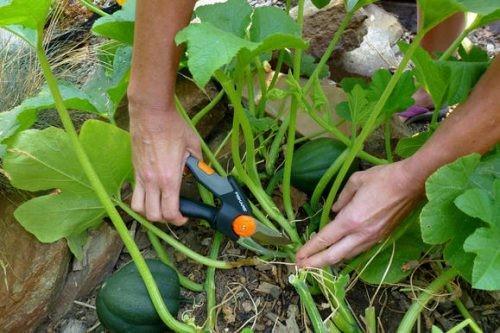Formation of pumpkin melon
 The pumpkin belongs to melons and gourds, therefore it grows in lashes. As with watermelon care, pumpkin bushes need to be shaped. If we consider the "Butternut" pumpkin and the "Spaghetti" pumpkin, at the end of August it is necessary to start pinching the lashes to form and ripen the fruit. These two are the earliest varieties. If you grow large-fruited pumpkins, then you need to form the plants later.
The pumpkin belongs to melons and gourds, therefore it grows in lashes. As with watermelon care, pumpkin bushes need to be shaped. If we consider the "Butternut" pumpkin and the "Spaghetti" pumpkin, at the end of August it is necessary to start pinching the lashes to form and ripen the fruit. These two are the earliest varieties. If you grow large-fruited pumpkins, then you need to form the plants later.
Choosing the right place to plant your pumpkin
Unlike other melons and gourds, pumpkin - cold-resistant plant. It can withstand temperatures up to 10ABOUT From heat, but from strong and cold winds, the pumpkin can throw off the ovary. The ideal place to grow pumpkins is in an area protected from the wind, for example, behind the house. It is best to plant the pumpkin in a place well lit by the sun; under the hot sun, the pumpkin will need to be watered abundantly.
Pinching the growth point of the whip
Pumpkin whips always reach for the sun, grow south. Thanks to the sunshine and warmth, the pumpkin can spread the whips 3-4 meters in length. On such large shoots, too many fruits are tied, and they do not have time to ripen by the end of the season. Therefore, at the end of August, it is necessary to select two large fruits on each lash, and break the rest of the ovary. You also need to pinch each pumpkin whip, leaving 2-3 leaves after the selected fruits. Thus, the growth point of the bush is damaged, and all the nutrients go to the fruits.
If there are frosts in early September, then the fruits must be harvested in early August. The pumpkin does not tolerate frost, and if you do not have time to collect the fruits, then they will not be stored.
In August, you need to pay attention to the size of the ovary. If two pumpkins of different sizes are tied on one lash, then you should not cut such a lash, you just need to remove the smaller fruit.
Pumpkin variety selection
If there are a lot of slugs on the site, then you should pay attention to the varieties "Muscat" pumpkin and pumpkin "Spaghetti". The fruits of these varieties are medium in size, early ripening and sweet, but thick-skinned. Slugs do not eat such a pumpkin, and the harvest will be safe.
If you plan to grow pumpkin for seeds, then the best variety will be "Large-fruited" pumpkin. This variety is the most cold-resistant. The weight of the fruit can reach 90 kilograms, therefore, it will be possible to collect a lot of seeds and pulp.
If the pumpkin will need to be stored for a long time, then the best variety is "Hard-brown" pumpkin, its shelf life lasts up to 9 months.